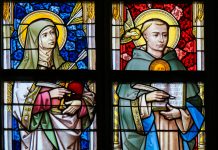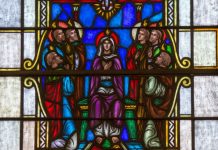
by Jeanne Heiberg
After a long drive home following a weekend workshop at beautiful Lake George, NY, I dropped friends off at a train station, did some errands, picked up some groceries, and spent a short time exercising at the gym. Just as I got back to my apartment and began to unpack my car, a visual migraine started. I had experienced that kind of thing before, but this time, the pain was intensified by an alarm clock going off inside one of my suitcases as I wrestled it upstairs. It could have been comical if not for the confusion and pain. Where was that clock? Stop that tortuous noise!
That is how I experienced a little of what Jesus’ crown of thorns might have felt like. In my pain, I felt close to Jesus and was grateful that I could count on him being close to me during my own times of pain, for he had suffered so much more.
I had a little bit of humor with the alarm clock, of course, plus aspirin, a bed to sink into that eased the pain, and friends with information on how to deal with migraines. Jesus, with his crown of thorns, had nothing ahead but a terrible death. And he did it all for us!
Church of the Holy Sepulcher
Through the centuries, faithful disciples of Jesus, grateful to him for what he suffered for all of us, have followed in the footsteps of his Passion, literally, in the places where it happened. It began in the fourth century, after the persecutions of Christians ended. Pilgrims began to flock to Jerusalem, especially during Holy Week.
A focal point during that time was the Church of the Holy Sepulcher, built in 335 by the Emperor Constantine. The church marked the reputed tomb of Jesus. The thousands of pilgrims who came from all over the world would begin their walk where Jesus did, at the Garden of Gethsemane, and proceed to Calvary along the route Jesus followed. They would stop to remember and pray at significant points, or “stations,” along the way until, at the Church of the Holy Sepulcher, they would celebrate the Eucharist.
Stations in the Middle Ages
During the Middle Ages (approximately 500 to 1500), the practice of praying the stations marking Jesus’ suffering and death developed further. Following the collapse of the Roman Empire came times of great chaos, confusion, and suffering, followed later by plagues, wars, and widespread suffering. Not everyone had the means to go to the Holy Land. Also, there were centuries when the Holy Land was totally inaccessible to Christians.
Instead of losing this practice altogether, the people transported it to the cities, villages, and churches of Europe, where everyone who wanted to could participate. They did this by constructing images (stations) representing significant moments in Jesus’ suffering along his way to the cross.
Then, as the humanizing influence of Christianity touched people’s minds and hearts, interest in Jesus’ humanity grew. People became more interested in the details of his life, his feelings, his suffering. Suffering through hard times themselves, people loved Jesus for coming to share in their pain, to ease and heal them, to bring them hope.
Stations of the Cross Today
The Traditional Stations—14 of them—are based on Jesus’ historical route through Jerusalem on Holy Thursday and Good Friday, where pilgrims stop to remember and meditate on what happened at each location. The number 14 did not become standard until the eighteenth century, in Europe. Before that time, the Stations were fluid and varied from place to place.
Occasionally, people will pray using “stations” relevant to current concerns. For example, years ago I joined a march to call attention to the unjust working and living conditions of migrant farmworks. We stopped to pray the “stations” in fields and towns along the way to the state capital. In unity with Jesus’ Good Friday sacrifice, our prayers were from the heart, growing out of the lives and situations of farmworkers and others throughout the world who were suffering.
This pattern of meditating on Jesus and his cross in association with people suffering today continues. We do this at St. Patrick’s in Athens, New York. We carry posters depicting the Stations and stop on street corners, parks, and other areas to pray. We meditate on Jesus’ historical sacrifice and suffering, and pray for those suffering today.
A good website to help children pray the Stations of the Cross is cptryon.org/prayer/child/stations/.
The Traditional Stations of the Cross
I. Jesus is condemned to death.
II. Jesus carries his cross.
III. Jesus falls the first time.
IV. Jesus meets his mother.
V. Simon of Cyrene helps Jesus carry his cross.
VI. Veronica wipes the face of Jesus.
VII. Jesus falls the second time.
VIII. Jesus speaks to the women of Jerusalem.
IX. Jesus falls the third time.
X. Jesus is stripped of his garments.
XI. Jesus is nailed to the cross.
XII. Jesus dies on the cross.
XIII. Jesus is taken down from the cross.
XIV. Jesus is placed in the tomb.
The Biblical Way of the Cross
On Good Friday 1991, Pope John Paul II shared with the world the Biblical Way of the Cross. The Stations of this Way of the Cross, approved for meditation and public celebration, are:
First Station: Jesus in the Garden of Gethsemane.
Second Station: Jesus, Betrayed by Judas, Is Arrested.
Third Station: Jesus Is Condemned by the Sanhedrin.
Fourth Station: Jesus Is Denied by Peter.
Fifth Station: Jesus Is Judged by Pilate.
Sixth Station: Jesus Is Scourged and Crowned with Thorns.
Seventh Station: Jesus Bears the Cross.
Eighth Station: Jesus Is Helped by Simon the Cyrenian to Carry the Cross.
Ninth Station: Jesus Meets the Women of Jerusalem.
Tenth Station: Jesus Is Crucified.
Eleventh Station: Jesus Promises His Kingdom to the Good Thief.
Twelfth Station: Jesus Speaks to His Mother and the Disciple.
Thirteenth Station: Jesus Dies on the Cross.
Fourteenth Station: Jesus Is Placed in the Tomb.
Say to the Children
During the season of Lent, Catholics want to feel closer to Jesus in thought and prayer. One practice begun many centuries ago is called the Stations of the Cross. People would travel to Jerusalem and, on Good Friday, walk in Jesus’ footsteps from the Garden of Gethsemane to the hill of Calvary, stopping to remember what happened at different places along the way. Those different places are called “stations.”
Because most people couldn’t go to Jerusalem to do this, though, the practice grew of picturing those same stations so that people could pray as if they were there, wherever they could gather: in parishes, monasteries, churches, chapels, and cathedrals in cities and towns all over the world. People could pray the Stations of the Cross alone or with others anywhere.
Most churches today have images of the Stations on their walls. There are also many outdoor presentations of the Stations of the Cross. Sometimes groups of people will place images of the Stations on poles and process through the church grounds or parks with them, sharing the prayer with whomever would like to join in. There are small prayer books of the Stations, usually showing one Station on the left-hand page and a prayer and reflection to go with that Station on the right-hand page. These booklets assist us in praying the Stations of the Cross anywhere and anytime: with a group in church or outside, at home with our families, or in our rooms by ourselves.
What Jesus did for us is huge. What he suffered for us is enormous. We sometimes cannot take it all in at once. Each of the 14 Stations of the Cross helps us to meditate on Jesus and what he endured during each step of his suffering. If we want to pray the Stations but 14 feels like too much, we can pray only a few, or just one. We can even take a few days to hold just one in our minds and hearts before moving on to another. The important thing is to feel Jesus’ love, to thank Jesus, to listen to him, and to tell him of our concerns, hopes, and dreams—and then to listen again.
Let’s make Stations of the Cross for our classroom. Each Station will be a simple cross and we’ll put the number of the Station and the words below the cross.
Stations of the Cross Craft
MATERIALS
* 6” x 9” foam sheets in different colors
* 9” x 12” foam sheets to frame and back each cross if you wish (foam frames are available at craft stores)
* scissors
* glue
* craft sticks (thin and colorful) or straws
* 3” x 5” cards
Option: You can use tree twigs to make the crosses, tying two together where they cross. Construction paper or card stock also can be used for the crosses or as background.
PROCEDURE:
1. Form craft sticks into a cross on a 6” x 9” foam sheet. Use two sticks for a simple cross, or add more in different colors to make the cross more elaborate.
2. When you like the arrangement, glue the sticks to the foam sheet.
Option: If you use twigs, cross them and repeatedly circle twine or yarn around the center to hold them together. Leave the two ends of the twine or yarn long enough to extend up and over the top and to the back of the foam. Tape the two ends to the back to hold the cross in place.
3. Mount the smaller piece of foam to a 9” x 12” foam sheet to frame and strengthen the smaller piece. Or place a foam frame around the cross.
4. Have children write on 3” x 5” cards the number (Arabic numerals such as 1, 2, 3, or Roman numerals such as I, II, III) and the name of each of the Traditional Stations of the Cross (or generate this on a computer). When Stations are hung on the walls around the classroom, place a 3” x 5” card below each one.
Prayer of Blessing over the Stations of the Cross
On your prayer table, place the 14 Stations of the Cross the students made.
Blessing: Loving Lord, how can we ever thank you for all that you have done for us, for coming to us to teach us about unconditional love, for refusing to let evil turn you away from your redeeming sacrifice that opened the way to heaven for us forever? In memory of your saving actions, we have made these Stations of the Cross. We ask your blessing on them, Loving Lord. When we pray the Stations of the Cross, may we grow closer to you, braver and stronger in faith, and more compassionate toward others.
All: Amen.
Jeanne Heiberg is the author of Advent Arts and Christmas Crafts (Paulist Press) and Advent calendars (Creative Communications). She has taught art, writing, creative catechetics, and meditation, and has directed parish catechetical programs. She thanks Sr. Mary Mazza, Parish Life Director of St. Patrick of Athens Parish, for a recent and meaningful outdoor Stations of the Cross experience.
Copyright 2012, Bayard, Inc. All rights reserved. This article is protected by United States copyright and other intellectual property laws and may not be reproduced, rewritten, distributed, redisseminated, transmitted, displayed, published or broadcast, directly or indirectly, in any medium without the prior written permission of Bayard, Inc.
This article was written by the Catechist Staff and appeared in Catechist magazine, January 2012.
Image Credit: Thoom/Shutter Stock 559092118




